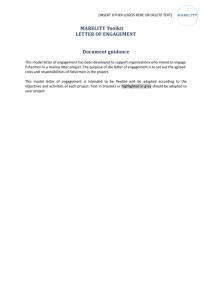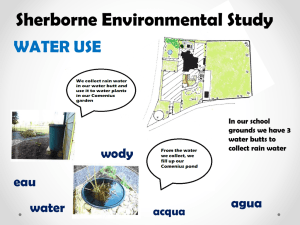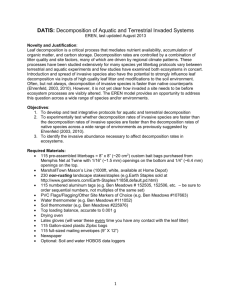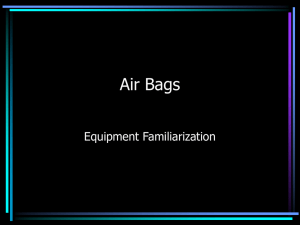datis - EREN
advertisement
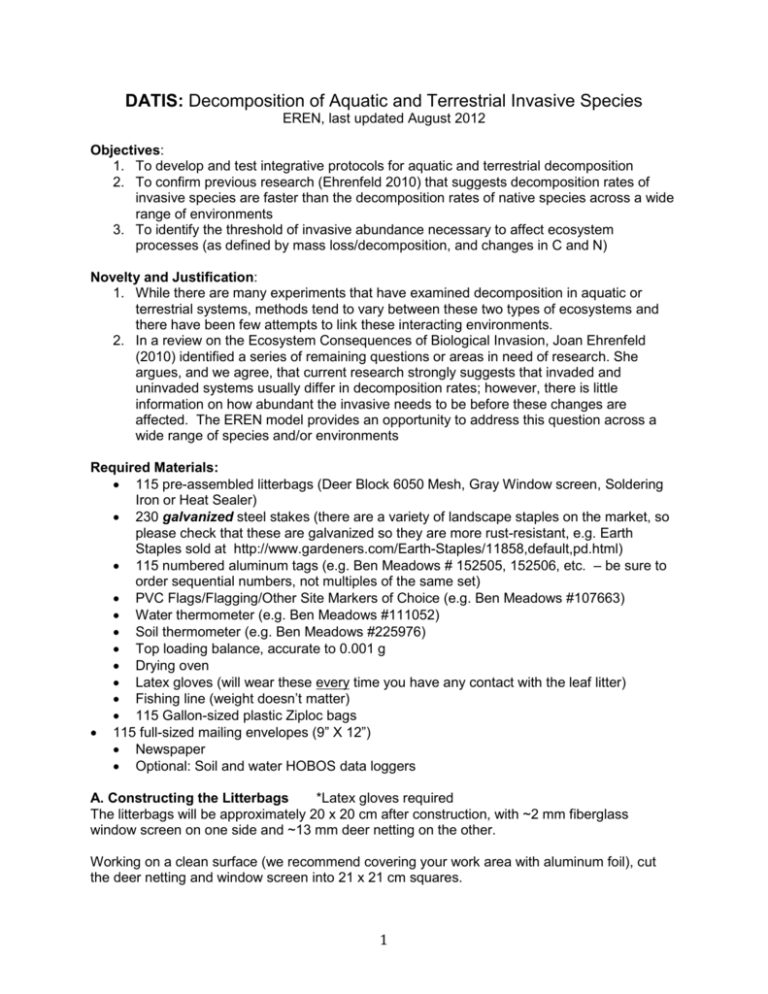
DATIS: Decomposition of Aquatic and Terrestrial Invasive Species EREN, last updated August 2012 Objectives: 1. To develop and test integrative protocols for aquatic and terrestrial decomposition 2. To confirm previous research (Ehrenfeld 2010) that suggests decomposition rates of invasive species are faster than the decomposition rates of native species across a wide range of environments 3. To identify the threshold of invasive abundance necessary to affect ecosystem processes (as defined by mass loss/decomposition, and changes in C and N) Novelty and Justification: 1. While there are many experiments that have examined decomposition in aquatic or terrestrial systems, methods tend to vary between these two types of ecosystems and there have been few attempts to link these interacting environments. 2. In a review on the Ecosystem Consequences of Biological Invasion, Joan Ehrenfeld (2010) identified a series of remaining questions or areas in need of research. She argues, and we agree, that current research strongly suggests that invaded and uninvaded systems usually differ in decomposition rates; however, there is little information on how abundant the invasive needs to be before these changes are affected. The EREN model provides an opportunity to address this question across a wide range of species and/or environments Required Materials: 115 pre-assembled litterbags (Deer Block 6050 Mesh, Gray Window screen, Soldering Iron or Heat Sealer) 230 galvanized steel stakes (there are a variety of landscape staples on the market, so please check that these are galvanized so they are more rust-resistant, e.g. Earth Staples sold at http://www.gardeners.com/Earth-Staples/11858,default,pd.html) 115 numbered aluminum tags (e.g. Ben Meadows # 152505, 152506, etc. – be sure to order sequential numbers, not multiples of the same set) PVC Flags/Flagging/Other Site Markers of Choice (e.g. Ben Meadows #107663) Water thermometer (e.g. Ben Meadows #111052) Soil thermometer (e.g. Ben Meadows #225976) Top loading balance, accurate to 0.001 g Drying oven Latex gloves (will wear these every time you have any contact with the leaf litter) Fishing line (weight doesn’t matter) 115 Gallon-sized plastic Ziploc bags 115 full-sized mailing envelopes (9” X 12”) Newspaper Optional: Soil and water HOBOS data loggers A. Constructing the Litterbags *Latex gloves required The litterbags will be approximately 20 x 20 cm after construction, with ~2 mm fiberglass window screen on one side and ~13 mm deer netting on the other. Working on a clean surface (we recommend covering your work area with aluminum foil), cut the deer netting and window screen into 21 x 21 cm squares. 1 Place the deer netting on top of the window screen. On one edge, lift and fold the window screen approximately ½ inch over the deer netting, Place a ruler over the fold, or use binder clips, to hold it in place while you iron the edge flat until it forms a tight seal. Repeat the process until three of the four sides are sealed. Note that a “seal-a-meal” heat sealer can also be used instead of the soldering iron to seal the edges; in both cases, the idea is to melt the window screen to fuse the two sides together. B. Gathering Leaves and Filling the Litterbags *Latex gloves required Gathering Green Leaves for Analysis of Plant Functional Traits (including C, N, Lignin, and Surface Area): Select a woody invasive species and a morphologically and functionally similar woody native species in your location. We recommend smooth sumac (SS) and tree of heaven (TOH), but if this is not in your area or you have already been working with other species pairs, you may select other invasive:native pairings. Contact the lead scientists should you have questions about your proposed pairing. For each species, while the leaves are still fully green (ideally during the summer), gather 5-6 fully expanded and hardened leaves from each of 5-10 adult plants without obvious symptoms of pathogen or herbivore attack and without substantial cover of epiphylls. (The replication for this material is based on individual plants so ideally you want to collect 5 to 6 leaves per plant from at least 5 different individuals, though 10 individuals is ideal). If your plant has compound leaves, you will only need up to 2 compound leaves per plant. Leaves should come from the same plants that you are planning to collect senesced material for the decomposition study. Put the leaves in sealed plastic bags to minimize desiccation. To minimize bending of the leaves, keep the samples (petioles or if possible raquis with leaves attached) flat using cardboard panels or strong paper sheets. Mail the leaves to the address below using the Priority Mail Padded Flat Rate Envelope service (Envelope size: 12-1/2" x 9-1/2") provided by the US Postal Service. In the East Coast, it takes about 2 -3 days for packages to arrive and the cost should be less than $10. Write PLEASE DO NOT BEND on the envelope: Jose-Luis Machado Department of Biology Swarthmore College 500 College Avenue Swarthmore, PA 19081. Please email Jose-Luis (jmachad1@swarthmore.edu) when you ship the leaves so that he knows to look for them. Gathering Senesced Leaves for the Decomposition Experiment After leaf fall in the autumn (November-December), collect senesced or freshly-fallen leaves from the same plants that you used to gather green leaf material. Place 5-6 leaves from each of your 5-10 plants of each species in plastic bags to be mailed to Jose-Luis as specified in the previous section. All other senesced material can be collected into communal bags (but keep the two species in separate bags; garbage bags work well). 2 Immediately bring the leaf litter that will be used for the decomposition experiment to the lab. Keeping the two species types separated as you work, moisten your samples with DI water, remove the leaflets from the leaf stalk, flatten the leaflets in newspaper, and allow the leaves to dry at room temperature (~25º C) for 24-48 hours or until constant weight. (You may discard the leaf stalk after these steps are complete. If you are using a species with simple leaves, snip off and discard the petiole). Once the samples have reached constant weight, remove them from the paper. Weigh out sets of 8 g of leaves at different percents of the two species to create samples with the following five litter combinations (we use notation assuming smooth sumac (SS) and tree of heaven (TOH) as the species pair): Litter Combination 1 (LC1): 100% SS/0% TOH (8g/0g) Litter Combination 2 (LC2): 75% SS/25% TOH (6g/2g) Litter Combination 3 (LC3): 50% SS/50% TOH (4g/4g) Litter Combination 4 (LC4): 25% SS/75% TOH (2g/6g) Litter Combination 5 (LC5): 0% SS/100% TOH (0g/8g) For each sample, record the mass to the nearest 0.001 g, (Initial Mass, 25C) and place each sample set in a separate mesh bag along with a numbered tag. It is helpful to work with the window screen side of the litterbag DOWN to minimize loss of material. Record this tag number (Tag), along with the % of each species (SS/TOH). Fold the window screen side of the open edge over the deer-netting and seal with an iron as above (all four sides of the litterbag should be sealed at this point, with the litter inside). You will need to make 23 litterbag samples for each litter combination (5 replicates x 2 locations x 2 collection times + 3 travel controls). This will result in a total of 115 bags that will be used for the experiment, including 15 travel bags that will be used to correct for leaf loss during travel to the site and for oven-dry correction. Using your remaining litter, you will need to calculate an air- to oven- dry conversion factor. Weigh out 5 sets of samples (8 grams for each preferred, but can adjust down as necessary if you are running low on leaf material) for each species. Record these weights. Place these samples into the oven to dry at 65ºC until they are at constant weight (24 to 48 hours). Weigh these samples again and use this final mass to calculate the “25ºC to 65ºC” conversion factor. After the leaf bags are prepared, one each of the 5 different treatment leaf bags should be strung together in random order using a single, long piece of fishing line to weave through the mesh (as depicted in Fig. 1). This will create a total of 23 strings of leaf bags: 3 will be travel bags, 10 will be placed in the aquatic site and 10 will be placed in the terrestrial site. Figure 1. Example string of the 5 litter combinations The strings of bags should be stored in covered plastic containers until they can be placed at the selected sites. C. Installing the Litter Bags *Latex gloves required Bags should be installed as soon as possible after they are made (fall or early winter). 3 Select two nearby sites for litterbag placement: a stream placement site and an upland site close to the stream. The location of placement in the stream should be in an area that will cover the bags with flowing water at all times, preferably downstream from a riffle. The upland site should be near the stream (record distance), but should not be in the riparian zone or where the leaf packs would be submerged. If possible, litter bags be placed so that they are not on a steep slope; if on a slope, then place the litterbags perpendicular to the slope so that all the litterbags in a replicate string are at the same elevation on the slope. At the predetermined field upland location, lift off and set to the side the litter from a spot large enough to place each string of mesh bags in five replicate blocks (see figure below). Place the leaf-filled mesh bags with the window screen side DOWN, so that they have flat contact at the soil surface, pin each individual bag in place using steel staples or stakes You can use a single staple to pin two adjacent bags on the same string by placing the pin in the corners as shown in the figure below. Mark the location with a flag, or if you are in a higher-traffic site and you are concerned about people removing your materials, you can use a triangulation method to mark the location of your bags by marking nearby areas – how you mark your samples is up to you, but the key is that you are able to relocate them. Record the date of placement (deployment), and topographic position (topo). X 5 replicate blocks Optional: Attach the sensor of a HOBO temperature logger to the soil surface (beneath the litter layer) near one of your replicate blocks. Set the logger to record temperatures at hourly intervals for the duration of the experiment. Repeat the installation procedure in the stream location. At the predetermined field stream location, place the leaf filled mesh bag at the stream bottom with the window screen side DOWN, and pin it in place using steel staples or stakes. Mark the location with flagging. Optional: To monitor water temperature place the sensor of one or more HOBO temperature loggers into the water at the stream location and covered with water at all times and preferably downstream from a stream riffle. Set the logger to record temperatures at hourly intervals for the duration of the experiment. 4 Take the travel bags to the field and back during installation and treat them as you would your actual samples. When you are leaving the field, place the travel bags into a plastic bag. When you return to the lab, remove each litterbag from the plastic bag and genly rinse each litterbag with DI water (over a sieve) to mimic how you will rinse soil that is attached to the outside of the litter bag on your actual samples. Then, transfer the litterbag (and any litter pieces that you retrieved from the sieve) into a clean paper mailing envelope, and place the envelopes into an oven to dry at 65ºC for 48 hours (until constant weight). Weigh the litter from these oven-dried bags to calculate your “travelling and processing correction factor”. Save these travel bags to be used for initial nutrient analyses and ash-free dry weight corrections. These litter bags can be stored flat in the clean paper envelopes at room temperature (25ºC). D. Gathering MetaData* General Site Variables: Site name: provide a name for the site that includes 6-12 characters, no spaces Habitat Type: specify as Aquatic or Terrestrial Litterbag installation date: record the DD_MM_YYYY of litterbag installation Litterbag retrieval date: record the DD_MM_YYYY of litterbag retrieval Latitude and Longitude: Record the GPS coordinates at the center of the site in the format: Latitude: (decimal degrees) and Longitude: (decimal degrees) Elevation (m): Record the elevation of the center of the site in meters Aspect (): If on sloped ground, record the azimuth that the slope faces; if on flat ground, record the azimuth as “na” Slope (%): If on sloped ground, record the average % slope across the site. If the plot is on flat ground, record the slope as “0”. Avg. Annual Temperature: Record the temperature in degrees Celsius. Temperature data source: Indicate if the source is LOCAL or obtained from the web. If the source is the WEB, indicate the site used to obtain the data. Average Annual Precipitation: Record the precipitation in mm. Precipitation data source: Indicate if the source is LOCAL or obtained from the web. If the source is the WEB, indicate the site used to obtain the data. Metadata Specific to Terrestrial Habitats: Type of Soil: Record the soil type as based on the USGS Soil Survey (http://websoilsurvey.nrcs.usda.gov/app/HomePage.htm) 5 Soil Moisture: Soil samples should be collected at each sampling location to characterize the site. Collect a 5 g soil sample and place it in a sealable plastic bag to measure soil moisture. Weigh it fresh, then dry it at 65º C and reweigh it to get oven-dry mass. Collect a sample of the forest floor (soil organic horizon (Oi/Oe/Oa) by using a wooden square or other straight edge to mark a 25 x 25 cm square in the forest floor at each location. Cut along the straight edge and collect all of the forest floor within the square down to the beginning of the mineral soil layer. Place the sample in a brown bag labeled with the watershed, location, and date, and dry at 30ºC. Collect a mineral soil sample from each location. Use a hand shovel and collect mineral soil to a 10 cm depth at 6 spots at the location. For each location combine the 6 samples, mix thoroughly, and place a 100 g sample in a sealable plastic bag and label it. All soil samples should be analyzed for pH, texture, and soil organic matter. % Bare soil: Rank the level of bare ground (neither forest floor or vegetation) for the plot from 0 to 5 using the following scale: 1) < 25% 2) 25 to 49% 3) 50 to 74% 4) 75 – 95% 5) 96 to 100% Soil temperature: Record the soil temperature (4 cm depth) at the time of sampling Metadata specific to Aquatic Habitats: Stream Order: Type of substrate: specify whether rocky or soft-bottom Stream width Stream depth Water temperature at the time of deployment/retrieval General Vegetation Variables Dominant Plant Species: Please list the dominant 2-3 plant species and their relative cover in the area, by ranking each on the following scale: 1) < 25% 2) 25 to 49% 3) 50 to 74% 4) 75 – 95% 5) 96 to 100% Invasive Species List: Please list the invasive plant species present at the site. Plot description: Please include a general description of the plot. Include such information as presence of trails, excessive vine coverage, deer browse, and cover of invasive plant species. E. Collecting the Litter Bags *Latex gloves required 6 Aquatic leaf litterbags should be collected 1-2 months and 3-4 months after deployment, while the terrestrial leaf litterbags should be collected at 3-4 months and 12 months. On each sample date, retrieve one string of mesh bags from each replicate block at each location. For terrestrial bags, brush off all external leaves and slide each mesh bag (you will need to cut the fishing line) so that it lies flat into a separate clean plastic bag for transport back to the lab. For aquatic bags, gently blot water off with paper towel and then slide each mesh bag so that it lies flat into a separate clean plastic bag (again, you will need to cut the fishing line) for transport back to the lab. When you return to the lab, remove each litterbag from the plastic bag and gently rinse each litterbag with DI water (over a sieve) to rinse soil that is attached to the outside of the litter bag on your actual samples. Then, transfer the litterbag (and any litter pieces that you retrieve from the sieve) into a clean paper mailing envelope, and place the envelopes into an oven to dry at 65ºC for 48 hours (until constant weight, approximately 2-4 days). Gently remove the contents of each mesh bag and place them on a clean aluminum tray or rolled out aluminum foil. Using gloves, remove roots, insects, label, and other materials that have entered the mesh bag. Record the label number and weigh the remaining material to determine the oven-dry mass of the remaining leaf material (Final Leaf Mass). Use the “25ºC to 65ºC” conversion you obtained earlier to determine the final leaf mass for each sample (Corrected Final Mass). Save all dried material (this can be kept in the paper bag at room temperature ~25ºC) for later reference, nutrient analysis and ash-free dry weight corrections. At the final collection period remove the HOBO data loggers from the field and download the data. (It would be better to download the data at each sampling period if possible). If not using HOBO, then record soil (4 cm depth) and water temperature at the time of collection using standard soil and water thermometers. F. Calculations We are compiling a data recording sheet that can be printed or downloaded to help with these calculations. [Note: All masses should be in grams] Mass(i) = Initial air-dry or 25°C mass ODMass(i) = Initial oven-dry (65°C) mass CF = 25°C-to-65°C conversion factor = ODMass(i) / Mass(i) TPCF = travelling and processing conversion factor = ODMass after travel and processing / Mass(i)*CF Mass(t) = 25°C leaf mass at time t ODMass(t) = Oven-dry leaf mass (65°C) at time t = Mass(t) * CF %ODMass Loss(t) = [(ODMass(i) - ODMass(t)) / ODMass(i)] * 100 Decomposition Rate (t) = %ODMass Loss(t) / Days of Incubation 7


